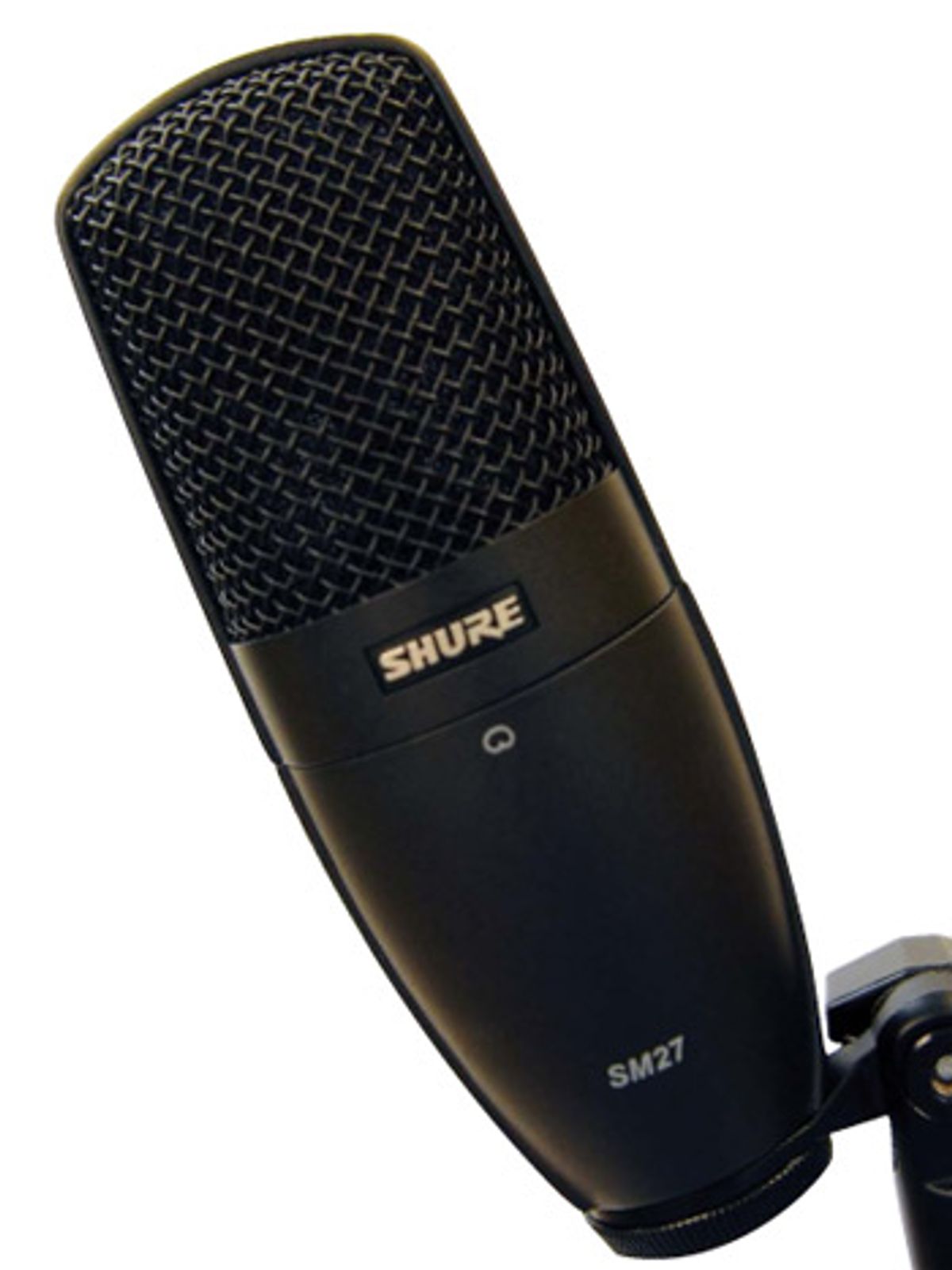
Will the SM27 replace the trusty 57?
There are many mics worthy of being in a
guitarist's studio or gig bag. Whether you're
mic'ing a cab, an acoustic soundhole, capturing
room vibe, serving vocal duty or maybe
a little bit of everything, the sheer number
of mics makes the choice daunting. And it
doesn't help that most companies describe
most of their mics as being able to handle
almost any application.
It's no wonder so many musicians keep it simple—limiting the breadth of their mic familiarity
to those famously affordable sticks, the
venerable Shure SM57 and SM58. After all,
they'll get you through many situations while
setting you back a mere hundy apiece.
Enter the SM27, Shure's side-address cardioid
condenser that promises to be a worthy
candidate for any working guitarist needing
a jack-of-all-trades mic in the $300 (street)
range. Originally rolled out as the entry-level
model in Shure's studio-leaning KSM line,
the 1" diaphragm FET condenser is a good
fit for the SM Series with its improved specs,
rugged housing and low-key looks.
Guts
The SM27 has a 20 Hz to 20 kHz frequency
response and an 84.5 dB signal-to-noise
ratio. It has a built-in Class A preamp and
requires 48-volt phantom power. It's a quiet
mic, with just 9.5 dB of self-noise (the KSM
version rated at 14 dB). With three different
mesh layers that reduce wind and pops,
and a -15 dB pad switch, it can handle SPLs
up to 152dB. There's also a low frequency
filter with three positions: flat, an 80 Hz
roll-off (via an 18dB octave filter) and a 115
Hz roll-off (via a 6 dB octave filter). The
mic is also equipped with an internal shock
mount. It comes with a soft gig case and a
simple hard mount. (The SM27-SC model
comes with a suspension shock mount and
a velveteen case.)
Testing, Testing…
Between the -15dB pad
and the roll-off options, the
SM27 really is like several different
mics rolled into one. Right
off the bat, the range of nuance
this mic translates is impressive
without being overbearing. Mic'ing the
acoustic soundhole of a Cole Clark Fat
Lady II (with somewhat old strings) revealed
a full sound and much of the rich character
that makes that guitar such a joy to play,
but without the overly biting string noise
that condensers tend to magnify when gritty
strings are involved. Doing the same with an
X-Series Martin dreadnought accurately captured
the tension between the guitar's lively unfinished spruce top and the tempered
resonance of its HPL back and sides.
The SM27 also worked well with cabs.
Attenuating the signal by 15 dB, it bore the
SPL brunt of an Orange Tiny Terror combo
and an Egnater 4x12 (hooked up to a JTM-
45) and delivered healthy, expressive signals.
It did make sense to back the mic up a bit in
both cases. At high volumes, being placed
4–6" further back from where a 57 was most
effective allowed the SM27's pronounced
bump in the 5 to 8 kHz range find a better
balance with the mic's colorful low-mids.
I didn't fully appreciate the SM27 until I realized
that every situation needed significant
experimentation with distance, axis angle,
pad, rolloff, and preamp fader manipulation
before finding the mic's own strengths. For
example, the SM27 needs more gain on a
Digidesign 003 preamp pot than I expected,
but once there I didn't find nearly as much
extra noise to deal with that usually tends to
come with that side of the taper.
Unexpected Delights
The SM27 worked really well as a bass cab mic,
pairing nicely with a Yorkville combo with 15
in it, and a kit cab with four 10s hooked up to a
GK Backline 600. I had full control of low-end
rumble with the roll-off switch. I'm partial to
well-framed bass note articulation with beefy
low mids, and this mic dialed it up easily. The
SM27 also came in handy during a session
with congas where 57s were working nicely
on the heads and a Rode NT1-A was doing
a great job with room 'verb from a distance.
We needed something near the floor by the
shells in order to fill out each drum's low tonal
character and the SM27 worked great, even
eliminating some ground vibration that two
other mics with shock mounts couldn't eliminate.
The mic also worked well for overhead
drums, even in a situation when a room's ceiling
was lower than preferred.
The Verdict
The SM27 has a wide vocabulary. It is truly
versatile and has a distinct character for
every situation. Learning to use that to your
advantage—for example, harnessing its
pronounced 5 to 8 kHz bump at the right
distance in order to elevate your lead sound
above the mix—is much more involved than
slapping a trustworthy handheld dynamic in
that familiar spot on the grill. So, I can't say
this mic is for just anyone. But, depending
on your experience and willingness to experiment,
this could be the ultimate microphone
for a one-mic kind of person with a $300
budget, or a great third mic for someone
looking to evolve a beyond the 57 and the
58. In fact, while A/B'ing this mic with a 57 I
ended up really liking it how well it worked
in concert with a 57.
This SM27 is musical and offers a lot of presence
that can coax some nice complexities
out of otherwise typical signals. I can't
say I experimented with vocals enough to
have found its strong points in that regard,
but its applications for guitarists and its
general versatility in the studio has me
convinced that Shure has designed another
microphone worthy of its place in the formidable
SM line.
Buy if...
you're willing to learn what this mic is capable of.
Skip if...
you're looking for a no-nonsense, one-trick-pony.
Rating...
Street $299 - Shure - shure.com |
